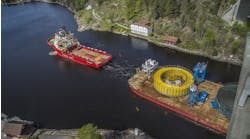A number of factors point to an increase in deepwater and ultra-deepwater drilling activity in the Gulf of Mexico. Commodity prices have stayed high for a considerable period. Oil is still above $40/bbl, and natural gas remains over $5/Mcf. As a result, oil company profits are up substantially. Lehman Brothers' midyear capex survey indicates a modest increase in E&P spending for a number of operators in the last half of 2004.
Rig day rates have been low (although lately showing significant increases) as a result of the expiration of term contracts from the 1998-2001 building boom. Of nine deepwater rigs in the GoM with contracts due to expire in 2004, most have new contracts or commitments.
The Environmental Protection Agency has found a way to issue discharge permits with the Administrative Compliance Order (ACO), which should improve permit processing for new wells. The MMS recently announced a number of discoveries in the GoM in 2004, and studies indicate that large reserves are still to be found in deepwater.
From 2005-2007, leases will expire on 1,204 blocks in water depths of 4,000 to 10,000 ft – creating a need to drill or relinquish before the end of that period. Western Gulf of Mexico Sale 192, held August 18, attracted $171,387,285 in high bids from 54 companies. Interest in deepwater and ultra-deepwater blocks was also high. Of the 193 deepwater tracts bid on, 37 are in water depths from 400 to 799 m, 101 in 800 to 1,599 m, and 55 in 1,600 m or greater. The MMS defines deepwater as 1,000 feet and ultra-deepwater as 5,000 ft.
At the same time. We are beginning to see an increase in deepwater plans of exploration and drilling permits. We still have not seen many plan of explorations for the new leases from Sale 190. This sale initially had 24 tracts in the 400-799 m range, 73 in 800-1,599 m and 91 in 1,600 m plus.
Apparently operator concern about the EPA's Administrative Compliance Order (ACO) is acting as a mitigating factor. National Ocean Industries Association and the Offshore Operators Committee are pressing for the speedy promulgation and effective date of the final requirements, which should clear up doubt and allow operators to move ahead with drilling plans without fear of unwittingly violating the order.
Not all indicators are positive, however. On the negative side:
- Many companies are risk averse
- Deepwater drilling and development costs are high
- Loop and eddy currents are difficult to predict, especially those affecting the Eastern Gulf. They can interrupt drilling and installation of production facilities, increasing costs
- It is difficult to predict success, as many wells in the Central and Western Gulf are subsalt
GoM deepwater leases provide opportunities in new exploration plays:
- Ample supply of deepwater rigs
- Large discoveries in new areas increase requirements for appraisal drilling
- Commodity prices remain very strong.
At this point, there are enough positive factors to outweigh the negative, and the pieces are in place to expect an upturn in GoM activity in the near future.
W.N. Plamondon, Jr.
P M Consultants
This page reflects viewpoints on the political, economic, cultural, technological, and environmental issues that shape the future of the petroleum industry. Offshore Magazine invites you to share your thoughts. Email your Beyond the Horizon manuscript to Eldon Ball at [email protected].


